
You spend hours comparing dog food brands, and making sure you buy safe toys for your pup, but did you know that water may be the most important step in keeping your dog healthy? If you’re wondering how to keep your dog hydrated, you’re in the right place.
Just like you, a dog’s body is around 80 percent water. This water is essential to help dissolve and carry substances throughout their body. It’s also the basis for most processes and chemical reactions that keep them healthy. Digestion, circulation, waste filtering, and body temperature regulation are just a few of the internal processes driven by water. If your dog is dehydrated, they can suffer kidney and heart damage, as well as other problems. So, here’s how to keep your dog hydrated.
Always ensure your dog has access to clean drinking water. A dog will need to drink about an ounce of water for every pound of weight daily but may need more if they have exercised, the weather is warm, or they are taking medication that may dehydrate them.
A good-sized bowl with twice the amount that they need is always a good rule of thumb. For large dogs, bowl/bottle combinations that feed a steady supply into the bowl as your dog drinks it are a good investment.
If it seems your dog is not getting enough water daily, check for signs of dehydration. These can include lethargy, dry gums, and sunken, darkened eyes. Then, get your dog to the veterinarian ASAP. If they are dehydrated, the vet can hook them up to an IV to quickly rehydrate them and also check them over to find the source of the problem.
How to keep your dog hydrated
Giving your dog water may seem easy enough, but here are some potential problems that are simple to avoid, and some solutions. Here’s how to keep your dog hydrated:
- Water bowls need cleaning daily. Bacteria can form on the rim and sides of the bowl which can turn the water foul quickly. Your dog may not want to drink from it, or worse, will drink from it and make themselves sick. Clean your dog’s water bowl each day with a dab of dish soap. If your dog uses a hanging water bottle on a crate or kennel, buy a bottle brush to give the inside a good scrub.
- Buy your dog a water bowl that they cannot knock over. A wide, weighted underside is best. Moreover, if your dog has the run of the house, place water bowls in two or three places.
- Always ensure your dog’s water bowl is full throughout the day, especially on warm days or cold, dry days.
- Don’t buy a water bowl that is too big for your dog. They may only be able to drink water part way down. A properly sized bowl is essential. Tall, narrow bowls are good for dogs with long ears like Bassets and Spaniels. Keeping their ears out of the water can help prevent infections. If you leave your dog a bucket of water, be sure they can still drink when it gets low. Furthermore, small dogs may fall into the bucket trying to get at the water.
- Dogs shouldn’t be chained or tied and left alone. They can wrap these chains and wires around trees or posts, shortening the chain to the point that they can no longer reach their water.
- The toilet bowl is not a water dish — despite the joy some dogs take in using it as one. Bacteria and deadly chemicals used to clean the toilet are just two of the dangers your dog faces if you let them do it. Put the lid down!
- On long walks or play times, take along a collapsible or portable water bowl and extra water. Dogs sweat through panting, which dries out their mouths.
- On long car trips, bring a couple of gallons of water from home to avoid digestive problems.
- Consult your veterinarian if you have any questions about providing water for your dog. In the meantime, a good, clean, plentiful supply of water will help your dog to be healthy and happy.
Adapted from the American Animal Hospital Association.









